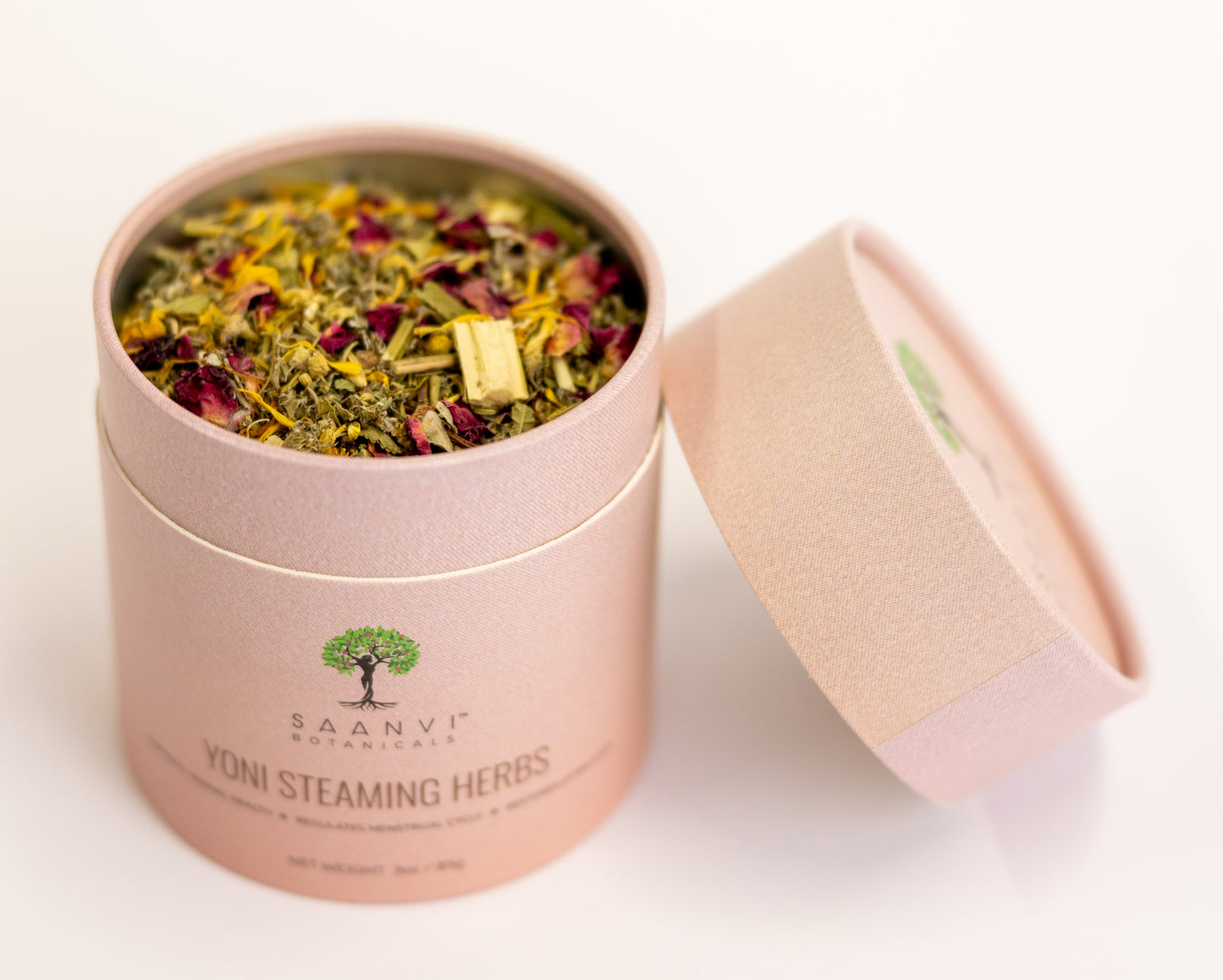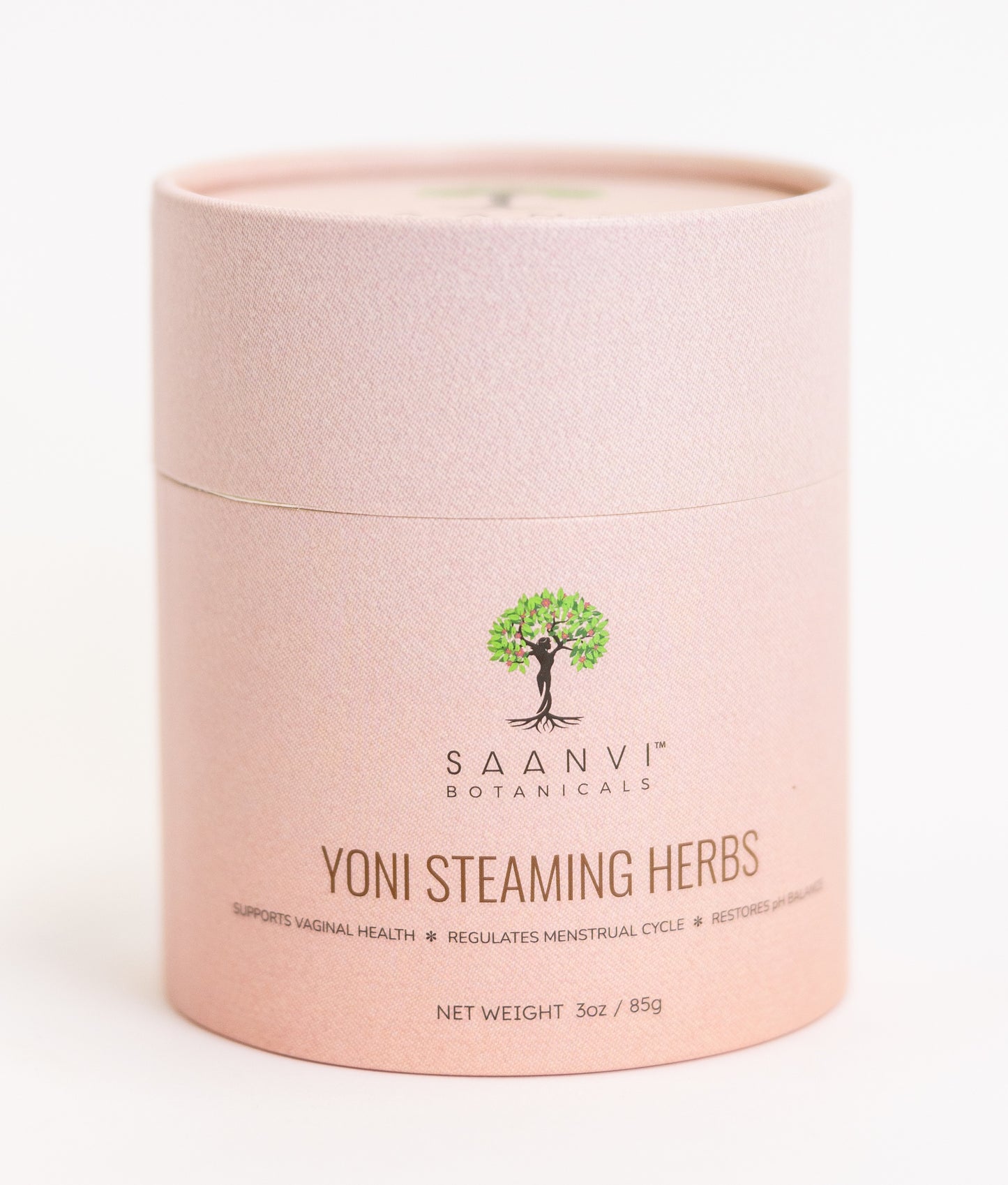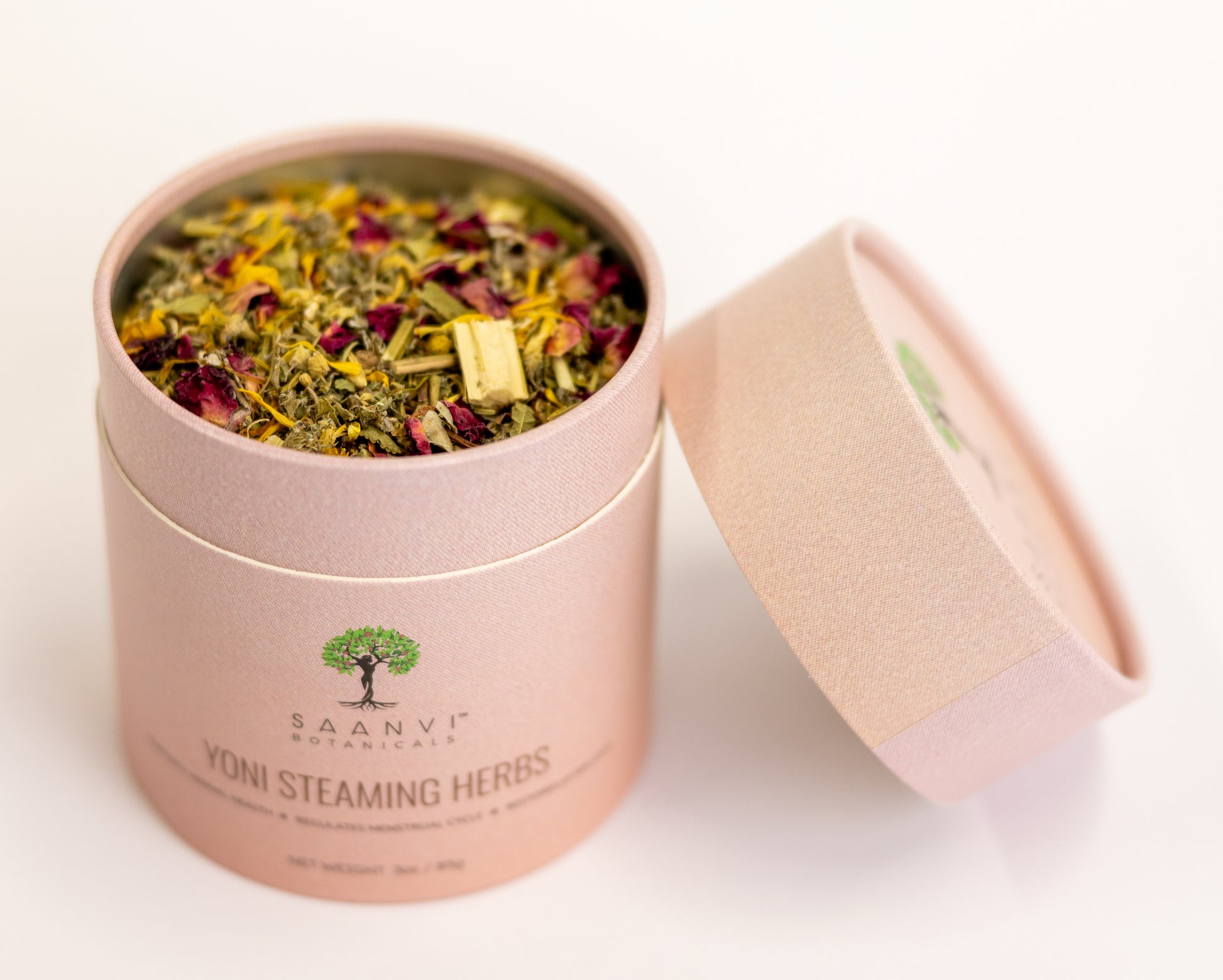FAQ (Yoni Steaming)
What is Yoni Steaming?
Also known as vaginal steaming or v-steaming, yoni steaming is a holistic health practice in which a woman allows the warmth of herbal steam to gently permeate her vagina. Yoni steaming is a powerful ancient remedy that has been used for centuries by women worldwide. This gentle treatment provides effective support for the female reproductive system, and invites reconnection with the powerful, creative energy of a woman's center.
A yoni steam gently and effectively cleanses, tones and revitalizes your womb, providing you with wide ranging benefits for reproductive health — from reduced menstrual cramps, to increased fertility, to heightened pleasure during intimacy. Respected by healers around the globe, yoni steaming is an opportunity to reconnect with your body and utilize the wisdom of herbs to promote healing of your cycle.
A yoni steam is also known as a vaginal steam, v-steam, bajo or chai-yok.
What are the benefits of Yoni Steaming?
🌿 Reduce symptoms of PMS, including pain, bloating and exhaustion, and heavy bleeding.
🌿 Decrease menstrual flow as well as reduce brown blood at the onset or end of menses.
🌿 Regulate irregular or absent menstrual cycles.
🌿 Increase libido, lubrication and fertility, while tightening the vagina.
🌿 Speed healing and tone the womb after birth.
🌿 Reduce uterine fibroids, ovarian cysts, uterine weakness, uterine prolapse and endometriosis.
🌿 Assist with the repair of a vaginal tear or C-section incision.
🌿 Maintain proper reproductive system pH and hormone balance.
🌿 Assist with the healing of hemorrhoids.
🌿 Relieve chronic yeast infections/bacterial vaginosis and support healthy odor.
🌿 Ease symptoms of menopause including dryness or pain during intercourse.
🌿 Detoxify the womb and body.
🌿 Release stored emotions and tap into the energy that is our creative potential.
What are the ingredients of Yoni Steam and what are their benefits?
Mugwort: In addition to fighting infection through its antibiotic and anti-fungal properties, mugwort balances female hormones and stimulates the production of hormones that help to maintain uterine health as well as protect the uterus from things such as ulcers and tumors. Mugwort steam opens the pores, allowing the beneficial herbs to penetrate into the blood stream.
Rosemary: An aromatic and antimicrobial herb, rosemary treats bacterial infection, speeds wound healing, inhibits yeast growth, and stimulates menstruation.
Chamomile: One of the most relaxing herbs we have, lavender supports healing, and it also promotes menstrual flow.
Yarrow: Astringent, tonifying and cleansing, yarrow is great for regulating menstrual flow, treating ovarian cysts and supporting overall uterine health.
Motherwort: Astringent, tonifying and cleansing, motherwort strengthens and relaxes uterine muscles, eases uterine cramping, and may help treat uterine fibroids. Motherwort stimulates uterine tone and blood flow.
Calendula: Aids in healing of scar tissue, vaginal tears, or hemorrhoids.
Rose Petals: A relaxing, uplifting and astringent herb that is wonderful for pampering.
Oregano: An antiseptic, antispasmodic, expectorant, Oregano helps to stimulate menstrual discharge and ease cramping.
Basil Leaf: Aids with cleansing and detoxifying the uterus and vagina.
Raspberry Leaf: It strengthens and tones the uterine and pelvic muscles, and is a pelvic and uterine relaxant.
Nettle Leaf: Because of its high vitamin and mineral content, it's also very helpful in postpartum recovery and fatigue. In addition to that, Nettle leaf is anti inflammatory, stress reducing, and it nourishes the adrenals.
Who should be yoni steaming?
Yoni steaming is a wonderful opportunity to reconnect with your body and reignite your vibrance. We encourage most women to try a yoni steam (aka. vaginal steam)! You are likely to see great benefit to this ancient remedy if you suffer from irregular or painful periods, infertility, uterine fibroids, perennial tears, bladder and yeast infections, vaginal or ovarian cysts, hemorrhoids or scarring from C-sections, hysterectomies and laparoscopies. Yoni steaming is also recommended even if you are not experiencing any of the above, as it is a great way to soothe and pamper yourself, and is known to relieve anxiety in women.
Who should NOT be yoni steaming?
First and most importantly, women who are pregnant, or think there is any possibility that they might be, should NOT do any type of yoni steam. Doing so may endanger the pregnancy, as many of the herbs used can alter hormone levels and can cause contractions of the uterus. For the same reason, it is also not recommended for women who have an Intrauterine Device (IUD). Women who have any type of internal infection (cervical, uterine or ovarian inflammation), or a fever, are encouraged not to steam until the symptoms have passed. Women also should not steam while menstruating or when open sores or blisters are present.
How often should I yoni steam?
Although we can offer guidance, there is no official prescription when it comes to the folk wisdom of yoni steaming. As part of an overall self care routine, we recommend you steam once during the week before your period begins (luteal phase), and once after your period ends (follicular phase). If you suffer from PMS, try yoni steaming 2-3 times within the week before menstruation to find relief from pain, bloating or exhaustion before your cycle and once it begins.
For fertility challenges, steam at least once per week for three months before intending to conceive. Steaming during ovulation will help to make sure that the tissue is moist and that the cervical fluids are clear and copious to support conception.
For postpartum recovery, wait at least one week and then steam up to three times per week for four weeks to facilitate healing and toning of the uterus and vagina. Please be sure there are no open wounds, and that you are no longer bleeding or passing lochia.
If you are menopausal or post-menopause, it will be helpful to steam at least three times per year for maintenance. Feel into what your body is calling for to determine the best yoni steam frequency for you.
How does a yoni steam work?
This ancient practice works by supporting your body through its natural processes.Many reproductive challenges such as menstrual cramps and infertility are caused when there is excess build up of uterine lining that was not shed in previous cycles “encrusted” to the inside of the uterus. Because this material is built up over time, the uterus and the muscles around it work excessively hard to shed it, often causing pain and fatigue.
A yoni steam works by infusing medicinal herbs into water, causing the molecular compounds of the beneficial plants to bond with the water vapor. During a yoni steam, this warm, herb-infused water vapor gently permeates the pores of the exterior of the vagina (the tissue referred to as the vulva) as you sit over your steaming pot. The molecular compounds are carried through subtle channels of the vagina and the uterus where they work to held cleanse and shed any excess build up of lining, breakdown abnormalities, and tighten the vagina. In addition, the warmth increases circulation to the vulva, causing it to swell and expose the inner labial mucus membranes — enhancing libido and lubrication. This process supports our body to do its best work in the same way that drinking ginger tea might support more comfortable digestion. The result is a healthier, more pleasant cycle and a more connected woman.
Why should a yoni steam not be done during menstruation?
During menstruation, the uterus is in its natural process of shedding and releasing. Because this is already an intense, downward moving energy, the added stimulation of a yoni steam may cause heavy bleeding and excess material to flow out. For this reason, it is best to yoni steam on the weeks in which the uterus is in its more restful state.
Why should a yoni steam not be done during pregnancy?
Yoni steams encourage the uterine lining to shed any excess build up each month. This is important to note because, in the case of pregnancy, the uterine lining is built up in order to create a nourishing haven for a fertilized egg and growing fetus. Therefore, anything that causes the uterus to contract and cleanse itself, such as a yoni steam, should be avoided so that the lining stays intact.
How long after birth should I wait to steam?
We recommend waiting until you are no longer bleeding before doing a yoni steam. Spotting, with dark colored blood, is okay. Obviously, in cases of extreme bleeding or hemorrhaging, a yoni steam would be contraindicated. There is not a point at which it is too late, as you will receive the benefits any time you decide to steam. Women who choose to do their first steam 4 or more months after giving birth often report getting their first cycle, even while still breastfeeding.
What should I expect after doing the steam?
During and immediately after your steaming ritual you will feel more relaxed, pampered, connected….and maybe even a little turned on! You won't likely see any visible results right away, however, your menstrual cycle can and does change after doing a yoni steam. Much of the discomfort you experience during menstruation is due to a build up of material in the uterine lining. Yoni steaming has the subtle but powerful ability to support the uterus to effectively cleanse and restore the lining with the support of the. Sometimes this means your next cycle will be very heavy, dark and thick, but after just a couple of months of regular yoni steaming, your next period will be much more light and pleasant. For more information on what to expect, and whether or not your results are "normal" check out our blog about yoni steam results.
Is Yoni steaming is safe and effective?
You may have read that some Western doctors are opposed to yoni steaming, disregarding it as unsafe or ineffective. This is in part due to a fundamental misunderstanding about how it works, so let’s clear that up first. Yoni steaming does not blow steam into the uterus, nor is the intention to get plant material into the vagina, as indeed those actions would be very invasive. A yoni steam works in the subtle channels, and as long as the steam is not too hot, this gentle process is safe and non-invasive.
Secondly, most Western doctors do not have any experience with this ancient women’s practice, as it is not something they learned in medical school. Perhaps this is due in part to the lack of scientific studies on the topic, as Western medical practice tends to disregard anything for which there is "no evidence" (i.e. no peer reviewed scientific studies). However, there is mounting evidence of the benefits of yoni steaming in the form of women’s lived experience that will soon be difficult to ignore. We take thousands of years of women’s testimonials, including widespread success stories today, as valuable evidence while we await scientific studies. It is our great hope that doctors see the safety and effectiveness of this practice soon, so that even more women may benefit.
Saanvi Botanicals
YONI STEAMING HERBS



